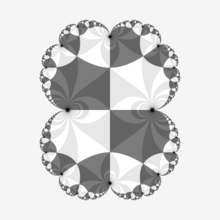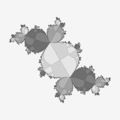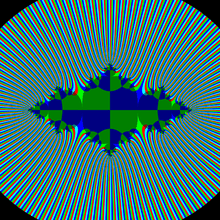Name
- Parabolic chessboard = parabolic checkerboard
- zeros of qn - use only interior of Filled Julia set
Algorithm

Color depends on:
- sign of imaginary part of numericaly aproximated Fatou coordinate (numerical explanation )
- position of under in relation to one arm of critical orbit star: above or below ( geometric explanation)
%3Dz%5E2_%2B_mz_where_p_over_q%3D1_over_3.svg.png)
Steps
First choose:
- choose target set, which is a circle with :
- center in parabolic fixed point
- radius such small that width of of exterior between components is smaller then pixel width
- Target set consist of fragments of p components ( sectors). Divide each part of target set into 2 subsectors ( above and below critical orbit ) = binary decomposition
Steps:
- take = initial point of the orbit ( pixel)
- make forward iterations
- if points escapes = exterior
- if point do not escapes then check if point is near fixed point ( in the target set)
- if no then make some extra iterations
- if is then check in what half of target set it ( binary decomposition)
Target set
- circle ( for periods 1 and 2 in case of complex quadratic polynomial)
- 2 triangles ( for periods >=3) described by :
- parabolic periodic point for period p , find
- critical point
- one of 2 critical point preimages ( a or b )
How to compute preimages of critical point ?
- (a,b)
- (aa, ab)
- (aaa,aab )
- (aaaa, aaab )
- (aaaaa, aaaab )
dictionary
- The chessboard is the name of this decomposition of A into a graph and boxes
- the chessboard graph
- the chessboard boxes :" The connected components of its complement in A are called the chessboard boxes (in an actual chessboard they are called squares but here they have infinitely many corners and not just four). " [1]
- the two principal or main chessboard boxes
description
"A nice way to visualize the extended Fatou coordinates is to make use of the parabolic graph and chessboard." [2]
Color points according to :[3]
- the integer part of Fatou coordinate
- the sign of imaginary part
Corners of the chessboard ( where four tiles meet ) are precritical points [4]
or
"each yellow tile biholomorphically maps to the upper half plane, and each blue tile biholomorphically maps to the lower half plane under . The pre-critical points of or equivalently the critical points of are located where four tiles meet"[5]
Images
Click on the images to see the code and descriptions on the Commons !
- on the real slice of Mandelbrot set
 on the cusp of main cardioid
on the cusp of main cardioid
 from main cardioid to period 2
from main cardioid to period 2 between period 2 and 4 along 1/2 ray
between period 2 and 4 along 1/2 ray
- on the boundary of main cardioid of Mandelbrot set
 0/1 = 1/1
0/1 = 1/1
 1/2
1/2 1/3
1/3
- other polynomials
_%3D_z%5E4_-_z_with_various_number_of_star_branches.gif) various number of star branches
various number of star branches
- orbits inside sepals
_%3D_z%5E2_%2B0.25.svg.png) 0/1 = 1/1
0/1 = 1/1 invariant curves inside main boxes
invariant curves inside main boxes
Examples :
code
For the internal angle 0/1 and 1/2 critical orbit is on the real line ( Im(z) = 0). It is easy to compute parabolic chesboard because one have to check only imaginary part of z. For other cases it is not so easy
0/1
Cpp code by Wolf Jung see function parabolic from file mndlbrot.cpp ( program mandel ) [8][9]
To see effect :
- run Mandel
- (on parameter plane ) find parabolic point for angle 0, which is c=0.25. To do it use key c, in window input 0 and return.
C code :
// in function uint mndlbrot::esctime(double x, double y)
if (b == 0.0 && !drawmode && sign < 0
&& (a == 0.25 || a == -0.75)) return parabolic(x, y);
// uint mndlbrot::parabolic(double x, double y)
if (Zx>=0 && Zx <= 0.5 && (Zy > 0 ? Zy : -Zy)<= 0.5 - Zx)
{ if (Zy>0) data[i]=200; // show petal
else data[i]=150;}
Gnuplot code :
reset
f(x,y)= x>=0 && x<=0.5 && (y > 0 ? y : -y) <= 0.5 - x
unset colorbox
set isosample 300, 300
set xlabel 'x'
set ylabel 'y'
set sample 300
set pm3d map
splot [-2:2] [-2:2] f(x,y)
1/2 or fat basilica
Cpp code by Wolf Jung see function parabolic from file mndlbrot.cpp ( program mandel ) [10] To see effect :
- run Mandel
- (on parameter plane ) find parabolic point for angle 1/2, which is c=-0.75. To do it use key c, in window input 0 and return.
C code :
// in function uint mndlbrot::esctime(double x, double y)
if (b == 0.0 && !drawmode && sign < 0
&& (a == 0.25 || a == -0.75)) return parabolic(x, y);
// uint mndlbrot::parabolic(double x, double y)
if (A < 0 && x >= -0.5 && x <= 0 && (y > 0 ? y : -y) <= 0.3 + 0.6*x)
{ if (j & 1) return (y > 0 ? 65282u : 65290u);
else return (y > 0 ? 65281u : 65289u);
}
See also
- Checkerboard in Hyperbolic tilings by User:Tamfang : images and Python code
- https://plus.google.com/110803890168343196795/posts/Eun6pZVkkmA
- shadertoy: Orbit trapped julia Created by maeln in 2016-Jan-19
- Holomorphic checkerboard by etale_cohomology
- Sepals of cauliflower
- wikipedia :Zebra striping in computer graphics
references
- ↑ Near parabolic renormalization for unisingular holomorphic maps by Arnaud Cheritat
- ↑ About Inou and Shishikura’s near parabolic renormalization by Arnaud Cheritat
- ↑ Applications of near-parabolic renormalization by Mitsuhiro Shishikura
- ↑ Complex Dynamical Systems by Robert L. Devaney, page
- ↑ Antiholomorphic Dynamics: Topology of Parameter Spaces and Discontinuity of Straightening by Sabyasachi Mukherjee
- ↑ tiles by T Kawahira
- ↑ checkerboards by A Cheritat
- ↑ commons:Category:Fractals created with Mandel
- ↑ Program Mandel by Wolf Jung
- ↑ Program Mandel by Wolf Jung
_Julia_set.png)
